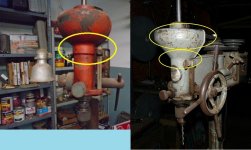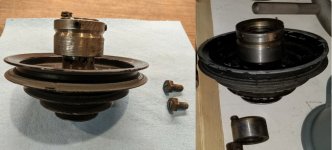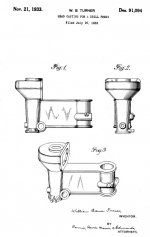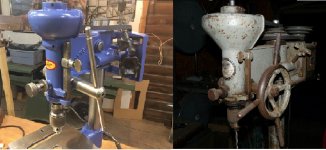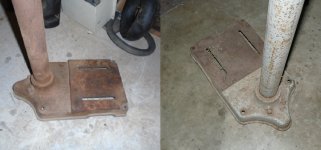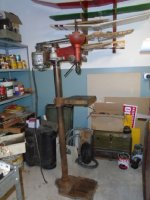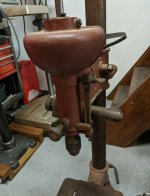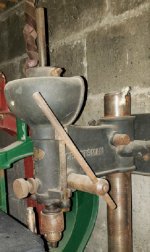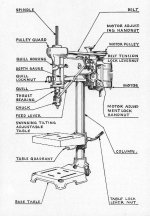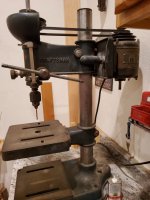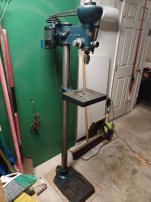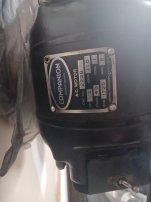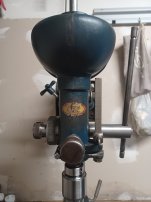The 1935 Craftsman/Walker-Turner 15 Inch Drill Press Mystery
Part 1
Part 1
A number of years ago I bought an old cast-iron 15 inch Craftsman drill press at an auction. It needed some repair and maybe paint, but all the parts were there and I thought it would make a useful addition to my workshop. When I got it home, I cleaned it up a little and looked for a tag with a model or serial number. To my surprise, I found that there wasn’t any nor was there any indication that there had been one at some time but had been removed. I thought this a little odd because I own a number of old cast-iron Craftsman tools and ALL of them had some type of ID number on them somewhere. So I hit the internet, and for the first couple of years, I found exactly nothing on this machine, no pictures, no manuals, no parts diagrams … nothing at all.
After about 3 years of looking, I finally found a photo of another Craftsman 15 inch drill press like mine on an internet forum. The problem was the owner didn’t know anything about his machine either except it had NO identification tags on it.
It’s now 5 or 6 years later and I have kept up my search. To date I have found photos of 9 of these d.p.’s, and have spoken with a reliable source who tells me that he had 3 of them in very bad shape that he broke up for parts. If you count mine, that makes a total of 12 of them.
Interestingly, of the ones I have photos of, six are 15 inch and three are 10 inch. There is a possibility that one of the 10 models is a 13 inch drill press. For more information please see photo number 5 below. Of the six 15 inch drill presses, two are floor models.
Over the years I have found a lot of speculation and guesses but little fact about these machines.
Most people seem to agree that these d.p.’s were built by Walker-Turner in the 1934-35 time-frame. These same people also say that Craftsman stopped dealing with Walker-Turner at the end of 1935 and began selling the Craftsman/Atlas drill presses in 1936.
Please note: For those who may not be aware, Sears never built any of their tools; they always put the Craftsman name on tools built by somebody else and sold them as their own.
I am not an expert or historian on drill presses. I am only reporting what I can see and trying very hard not to speculate. If you have information, manuals, parts diagrams, or anything else to add, or to correct me on, please share what you have.
I am only certain of two things: The 10 inch version of this drill press only appeared in the 1935 Craftsman power tool catalogue, and I have never seen a reference to the 15 inch model in any catalogue.
So where did the 1935 Craftsman/Walker-Turner 15 inch (and maybe a 13 inch) drill press come from?
After about 3 years of looking, I finally found a photo of another Craftsman 15 inch drill press like mine on an internet forum. The problem was the owner didn’t know anything about his machine either except it had NO identification tags on it.
It’s now 5 or 6 years later and I have kept up my search. To date I have found photos of 9 of these d.p.’s, and have spoken with a reliable source who tells me that he had 3 of them in very bad shape that he broke up for parts. If you count mine, that makes a total of 12 of them.
Interestingly, of the ones I have photos of, six are 15 inch and three are 10 inch. There is a possibility that one of the 10 models is a 13 inch drill press. For more information please see photo number 5 below. Of the six 15 inch drill presses, two are floor models.
Over the years I have found a lot of speculation and guesses but little fact about these machines.
Most people seem to agree that these d.p.’s were built by Walker-Turner in the 1934-35 time-frame. These same people also say that Craftsman stopped dealing with Walker-Turner at the end of 1935 and began selling the Craftsman/Atlas drill presses in 1936.
Please note: For those who may not be aware, Sears never built any of their tools; they always put the Craftsman name on tools built by somebody else and sold them as their own.
I am not an expert or historian on drill presses. I am only reporting what I can see and trying very hard not to speculate. If you have information, manuals, parts diagrams, or anything else to add, or to correct me on, please share what you have.
I am only certain of two things: The 10 inch version of this drill press only appeared in the 1935 Craftsman power tool catalogue, and I have never seen a reference to the 15 inch model in any catalogue.
So where did the 1935 Craftsman/Walker-Turner 15 inch (and maybe a 13 inch) drill press come from?
IDENTIFYING FEATURES.
The photo above shows what could be regarded as the identifying features of the 1935 Craftsman/Walker-Turner drill press (C/W-T d.p.’s). Number 1 shows the largest sheave of the 4 tier pulley facing up and at the top of its shaft (i.e., the “inverted pulley”). Number 2 is the smooth-sided upright bowl-shaped spindle pulley guard. Number 3 is the flange-shaped feature the bowl sits on. The bowl and flange are NOT removable from the head casting. Number 4 is the Craftsman logo on both sides of the head more-or-less centered top and bottom, left and right. Please note that this logo can also be located diagonally on some of these d.p.’s. Number 5 is the upward arch from rear to front of the head casting. Number 6 is the V-belt adjustment lock hand-nut.
Additionally, this drill press has NO model number or serial number tag on it anywhere. Walker-Turner did not begin putting ID tags on their machines until 1939. After that date W-T machines had the tags installed on their base, in front of the column.
All of these features can be found on each of the 10 inch and 15 inch versions of the nine 1935 C/W-T drill presses that I have found photos of and listed below.
Additionally, this drill press has NO model number or serial number tag on it anywhere. Walker-Turner did not begin putting ID tags on their machines until 1939. After that date W-T machines had the tags installed on their base, in front of the column.
All of these features can be found on each of the 10 inch and 15 inch versions of the nine 1935 C/W-T drill presses that I have found photos of and listed below.
In the photos above note the smooth-sided bowl shaped spindle guard and the flange feature (in yellow circle) of the 1935 Craftsman/Walker-Taylor d.p. on the left. Compare that with the somewhat flat sided bowl and the lack of a flange (yellow circles) of the 1934-35 Walker-Turner D921 on the right. As an aside, note the different feed levers.
ADDITIONAL FEATURES:
- These 1935 Craftsman/Walker-Turner machines can be found in 2 sizes, 10 and 15 inch. I have seen photos of the 10 inch size only as bench models, but the 15 inch can be found as either bench or floor models.
- There is an oval SKF Bearings decal on the front of the drill head of the original machines I have seen photos of.
- These machines all seem to have been fitted originally with 2 handled feed levers.
- There is only one fastener to secure v-belt tension instead of 2. The fastener is a 4-handled knob and not a bolt or grub screw. It’s located on the right side (facing) on 10 inch models and on the left side (facing) on the 15 inch models.
- From the photos of original, untouched machines I’ve seen, I believe these machines came painted in either red or blue. The 2 red ones I found are 15 inch floor models.
THE INVERTED PULLEY
Grey iron castings are just shapes which can be easily changed; it’s the Inverted Pulley that helps make the 1935 Craftsman/Walker-Turner drill press the odd duck that it is. So what is it?
Quickly stated, it’s an assembly comprised of a shaft, a couple of bearings, a locking collar, a four tier-step pulley with its largest sheave facing up (as seen in the photo above) and a woodruff key as seen in the photo below to guide and drive the spindle.
This assembly slides into the spindle pulley guard portion of the head casting from the back and is pushed upward into a machined recess located at the top of the pulley guard where it is held into place with a couple of threaded fasteners and locking nuts.
The photos above show spindle pulley, bearing and shaft assemblies. On the left is an assembly from a 1935 Craftsman/Walker-Turner drill press. Compare this with the photo seen on the right of the same assembly from a 1934-35 Walker-Turner D921 d.p. Although the dimensions and part numbers are unknown, obviously, they are very similar. This assembly is similar to those found in other drill presses first seen in the 1934 Walker-Turner and WT Grant Driver Line Power Tools catalogues.
Although I haven’t taken one apart yet, I’m told to make these things all the more interesting, the bearings are of an odd size and their construction is unusual which makes finding them difficult. Also, it’s said after the assembly has been in the head for about 87 years, removing it is nearly impossible. This is probably the reason very few drill presses use this method.
It should be noted that the photo on the left in this series is of a spindle pulley, bearing and shaft assembly from a 1935 Craftsman/Walker-Turner drill press listed on Ebay. This photo is used with permission of oldamericantools. It is from one of their Ebay sales. Oldamericantools has many parts from the 1935 Craftsman/Walker-Turner drill press listed on Ebay.
The photos above show spindle pulley, bearing and shaft assemblies. On the left is an assembly from a 1935 Craftsman/Walker-Turner drill press. Compare this with the photo seen on the right of the same assembly from a 1934-35 Walker-Turner D921 d.p. Although the dimensions and part numbers are unknown, obviously, they are very similar. This assembly is similar to those found in other drill presses first seen in the 1934 Walker-Turner and WT Grant Driver Line Power Tools catalogues.
Although I haven’t taken one apart yet, I’m told to make these things all the more interesting, the bearings are of an odd size and their construction is unusual which makes finding them difficult. Also, it’s said after the assembly has been in the head for about 87 years, removing it is nearly impossible. This is probably the reason very few drill presses use this method.
It should be noted that the photo on the left in this series is of a spindle pulley, bearing and shaft assembly from a 1935 Craftsman/Walker-Turner drill press listed on Ebay. This photo is used with permission of oldamericantools. It is from one of their Ebay sales. Oldamericantools has many parts from the 1935 Craftsman/Walker-Turner drill press listed on Ebay.
Attachments
Last edited:



